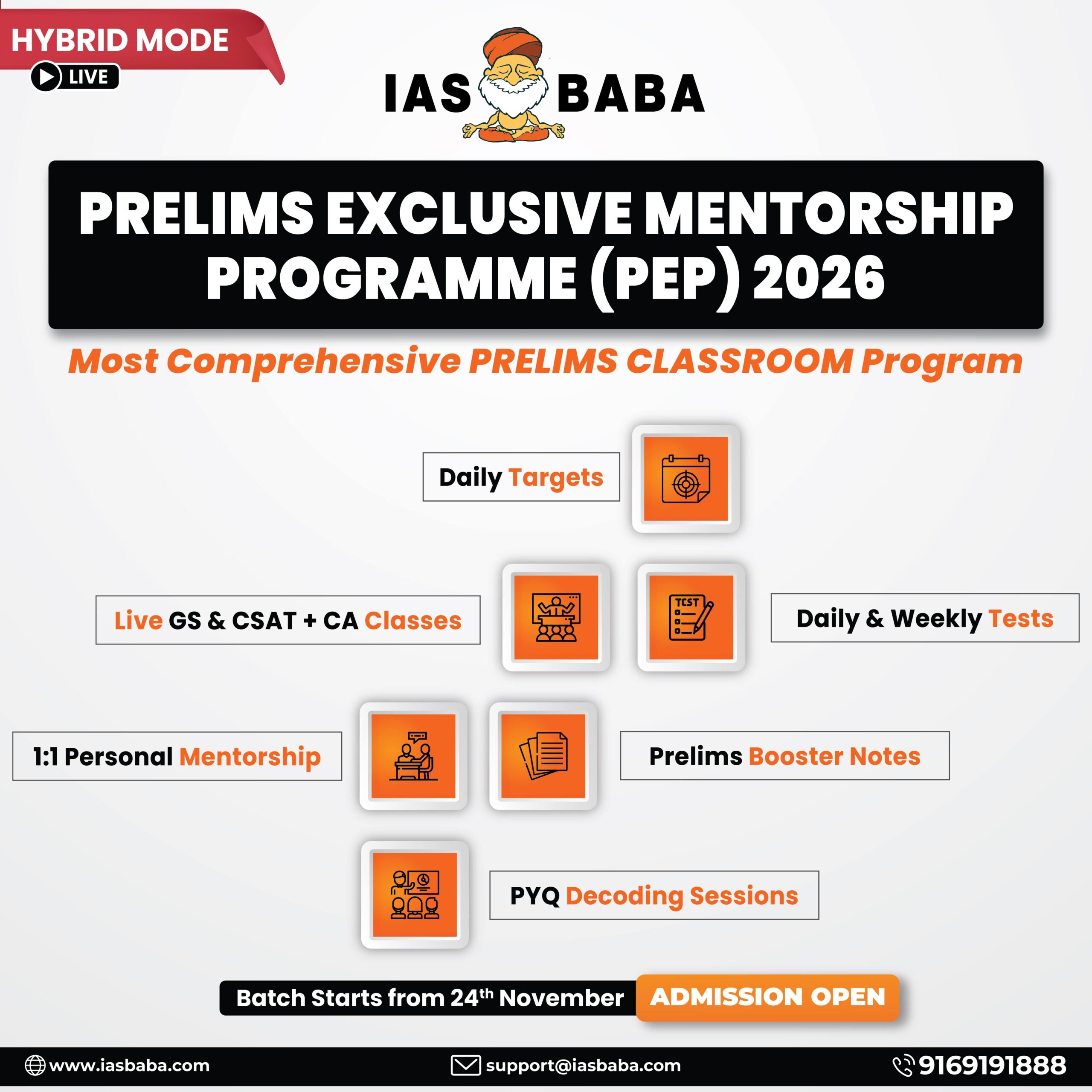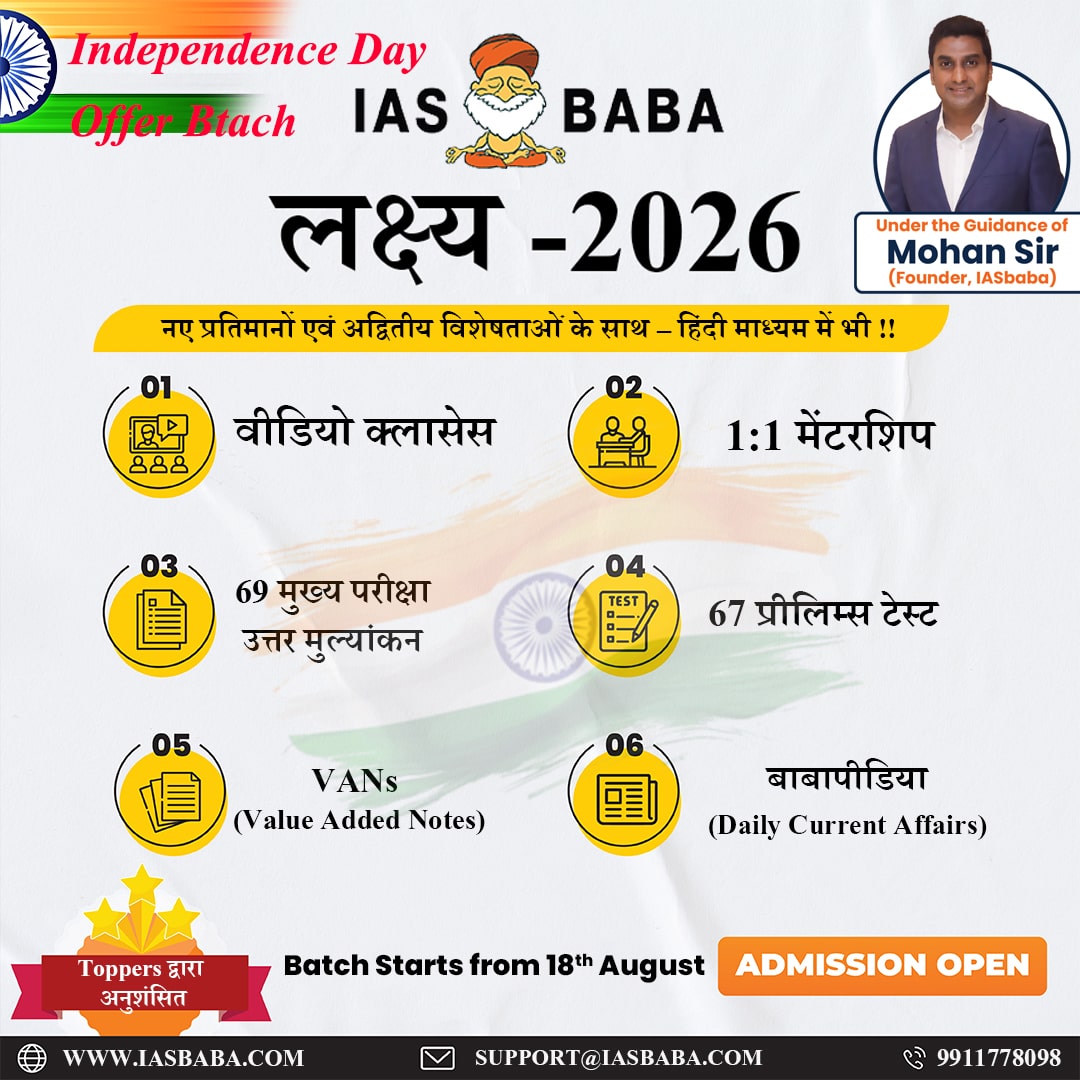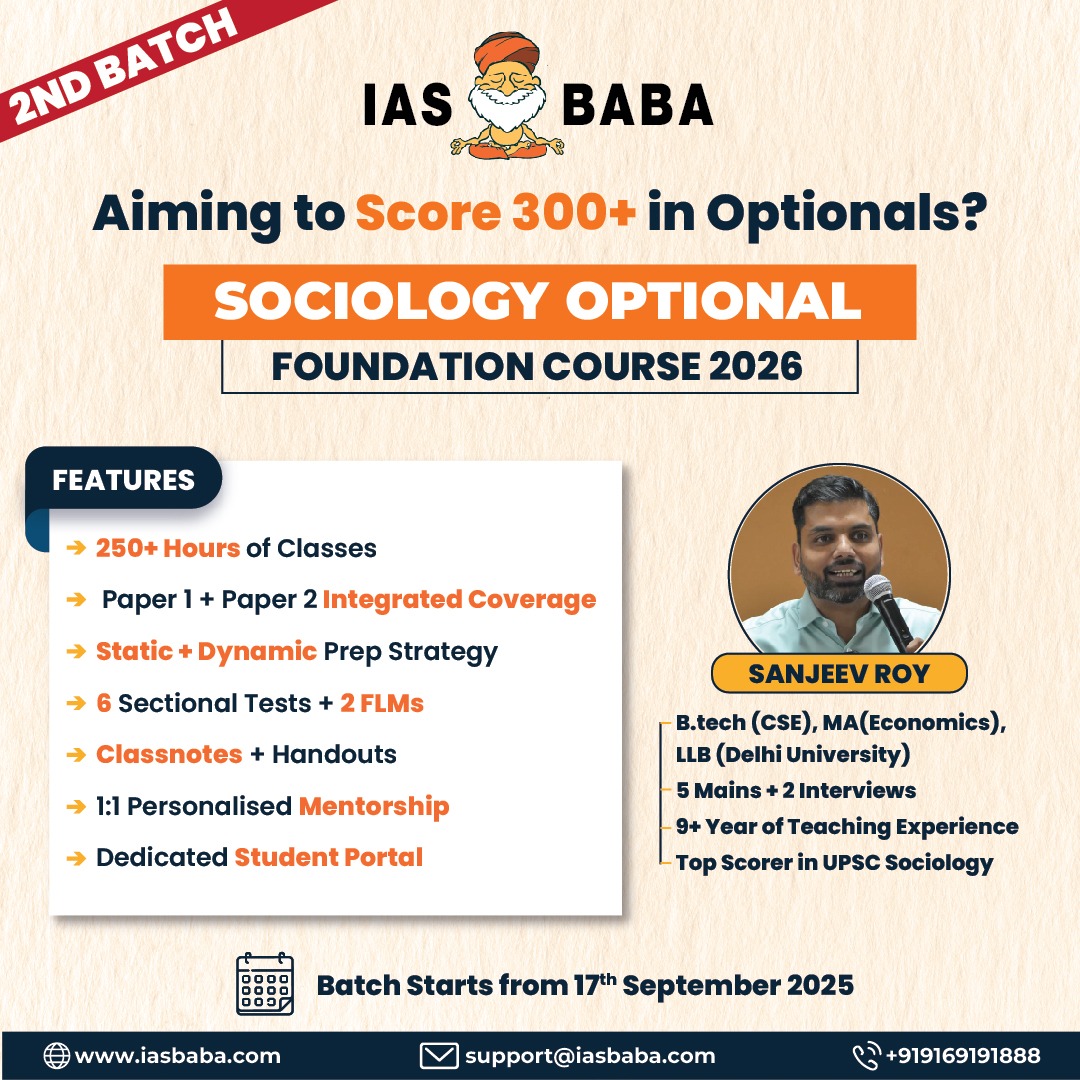IASbaba Daily Prelims Quiz
For Previous Daily Quiz (ARCHIVES) – CLICK HERE
The Current Affairs questions are based on sources like ‘The Hindu’, ‘Indian Express’ and ‘PIB’, which are very important sources for UPSC Prelims Exam. The questions are focused on both the concepts and facts. The topics covered here are generally different from what is being covered under ‘Daily Current Affairs/Daily News Analysis (DNA) and Daily Static Quiz’ to avoid duplication. The questions would be published from Monday to Saturday before 2 PM. One should not spend more than 10 minutes on this initiative.
Gear up and Make the Best Use of this initiative.
Do remember that, “the difference between Ordinary and EXTRA-Ordinary is PRACTICE!!”
Important Note:
- Don’t forget to post your marks in the comment section. Also, let us know if you enjoyed today’s test 🙂
- After completing the 5 questions, click on ‘View Questions’ to check your score, time taken, and solutions.
Test-summary
0 of 5 questions completed
Questions:
- 1
- 2
- 3
- 4
- 5
Information
To view Solutions, follow these instructions:
- Click on – ‘Start Test’ button
- Solve Questions
- Click on ‘Test Summary’ button
- Click on ‘Finish Test’ button
- Now click on ‘View Questions’ button – here you will see solutions and links.
You have already completed the test before. Hence you can not start it again.
Test is loading...
You must sign in or sign up to start the test.
You have to finish following test, to start this test:
Results
0 of 5 questions answered correctly
Your time:
Time has elapsed
You have scored 0 points out of 0 points, (0)
| Average score |
|
| Your score |
|
Categories
- Not categorized 0%
| Pos. | Name | Entered on | Points | Result |
|---|---|---|---|---|
| Table is loading | ||||
| No data available | ||||
- 1
- 2
- 3
- 4
- 5
- Answered
- Review
-
Question 1 of 5
1. Question
Which of the following correctly distinguishes between a Free Trade Agreement (FTA) and a Customs Union?
Correct
Correct Answer: A
Explanation:
- Option A: Correct.
FTAs focus on removing internal trade barriers but allow each member to set its own external tariffs. Customs Unions, in contrast, have a unified external tariff policy toward non-members. - Option B: Incorrect.
Free movement of all factors (goods, services, labor, capital) occurs in a Common Market, not in an FTA or Customs Union. - Option C: Incorrect.
A Customs Union represents a higher level of integration than an FTA.
Option D: Incorrect.
Both FTAs and Customs Unions can be bilateral or multilateral.Incorrect
Correct Answer: A
Explanation:
- Option A: Correct.
FTAs focus on removing internal trade barriers but allow each member to set its own external tariffs. Customs Unions, in contrast, have a unified external tariff policy toward non-members. - Option B: Incorrect.
Free movement of all factors (goods, services, labor, capital) occurs in a Common Market, not in an FTA or Customs Union. - Option C: Incorrect.
A Customs Union represents a higher level of integration than an FTA.
Option D: Incorrect.
Both FTAs and Customs Unions can be bilateral or multilateral. -
Question 2 of 5
2. Question
With reference to the Dhole (Cuon alpinus), consider the following statements:
- It is classified as Endangered on the IUCN Red List.
- It is found only in the Western Ghats region of India.
- It is protected under Schedule I of the Wildlife (Protection) Act, 1972.
- It is a solitary predator that avoids group hunting.
Which of the statements given above is/are correct?
Correct
Correct Answer: A. 1 and 3 only
Explanation:
- Statement 1 – Correct:
The dhole is listed as Endangered on the IUCN Red List due to habitat loss, prey depletion, and conflict. - Statement 2 – Incorrect:
While found in the Western Ghats, dholes are also distributed across Central India, Northeast India, and parts of the Himalayas. - Statement 3 – Correct:
It is protected under Schedule I of the Wildlife (Protection) Act, 1972—giving it the highest level of legal protection.
Statement 4 – Incorrect:
Dholes are highly social animals known for pack behavior and cooperative hunting.Incorrect
Correct Answer: A. 1 and 3 only
Explanation:
- Statement 1 – Correct:
The dhole is listed as Endangered on the IUCN Red List due to habitat loss, prey depletion, and conflict. - Statement 2 – Incorrect:
While found in the Western Ghats, dholes are also distributed across Central India, Northeast India, and parts of the Himalayas. - Statement 3 – Correct:
It is protected under Schedule I of the Wildlife (Protection) Act, 1972—giving it the highest level of legal protection.
Statement 4 – Incorrect:
Dholes are highly social animals known for pack behavior and cooperative hunting. -
Question 3 of 5
3. Question
Which of the following best illustrates the philosophical justification for promoting equality in a democratic society?
Correct
Correct Answer: C
Explanation:
- Option A – Incorrect:
Absolute economic equality is not a democratic aim; democracies focus on fairness and opportunity, not uniform wealth. - Option B – Incorrect:
Democracies aim for equality of opportunity, not equality of outcome regardless of individual effort. - Option C – Correct:
This reflects the core democratic ideal of equality—ensuring equal access to opportunities, dignity, and participation in public life.
Option D – Incorrect:
Imposing uniformity contradicts democratic values of pluralism and individual freedom.Incorrect
Correct Answer: C
Explanation:
- Option A – Incorrect:
Absolute economic equality is not a democratic aim; democracies focus on fairness and opportunity, not uniform wealth. - Option B – Incorrect:
Democracies aim for equality of opportunity, not equality of outcome regardless of individual effort. - Option C – Correct:
This reflects the core democratic ideal of equality—ensuring equal access to opportunities, dignity, and participation in public life.
Option D – Incorrect:
Imposing uniformity contradicts democratic values of pluralism and individual freedom. -
Question 4 of 5
4. Question
With reference to bonds as financial instruments, consider the following statements:
- Bonds represent a form of debt where the issuer borrows funds from investors.
- The yield of a bond moves inversely to its market price.
- Zero-coupon bonds pay no periodic interest but are issued at a discount.
- Convertible bonds give the investor the option to exchange the bond for equity shares.
Which of the statements given above are correct?
Correct
Correct Answer: D. 1, 2, 3 and 4
Explanation:
- Statement 1 – Correct: Bonds are debt instruments; the issuer (borrower) promises to repay the principal with interest to investors (lenders).
- Statement 2 – Correct: Bond yields and prices move inversely—when bond prices go up, yields go down, and vice versa.
- Statement 3 – Correct: Zero-coupon bonds do not pay periodic interest but are sold at a discount and redeemed at face value.
- Statement 4 – Correct: Convertible bonds can be converted into equity shares, giving investors both debt safety and potential equity upside.
Incorrect
Correct Answer: D. 1, 2, 3 and 4
Explanation:
- Statement 1 – Correct: Bonds are debt instruments; the issuer (borrower) promises to repay the principal with interest to investors (lenders).
- Statement 2 – Correct: Bond yields and prices move inversely—when bond prices go up, yields go down, and vice versa.
- Statement 3 – Correct: Zero-coupon bonds do not pay periodic interest but are sold at a discount and redeemed at face value.
- Statement 4 – Correct: Convertible bonds can be converted into equity shares, giving investors both debt safety and potential equity upside.
-
Question 5 of 5
5. Question
Which of the following best explains the term “triple burden of malnutrition” in the Indian context?
Correct
Correct Answer: B
Explanation:
- Option A – Incorrect:
This describes forms of undernutrition, but not the full “triple burden.” - Option B – Correct:
The triple burden of malnutrition includes:- Undernutrition (stunting, wasting, underweight),
- Micronutrient deficiencies (hidden hunger), and
- Overweight/obesity (overnutrition).
- Option C – Incorrect:
Focuses on demographic groups, not types of malnutrition.
Option D – Incorrect:
These are related issues but do not define the triple burden conceptually.Incorrect
Correct Answer: B
Explanation:
- Option A – Incorrect:
This describes forms of undernutrition, but not the full “triple burden.” - Option B – Correct:
The triple burden of malnutrition includes:- Undernutrition (stunting, wasting, underweight),
- Micronutrient deficiencies (hidden hunger), and
- Overweight/obesity (overnutrition).
- Option C – Incorrect:
Focuses on demographic groups, not types of malnutrition.
Option D – Incorrect:
These are related issues but do not define the triple burden conceptually.
- Current Affairs Quiz, IAS Daily Current Affairs Quiz, IAS UPSC Current Affairs Quiz, IAS UPSC Prelims Quiz, IASbaba's Current Affairs Prelims Quiz, IASbaba's Daily Quiz, IASbaba's UPSC Quiz, Prelims Current Affairs Quiz, UPSC Current Affairs Quiz, UPSC Current Affairs Quiz IASbaba, UPSC Daily Current Affair Quiz, UPSC IAS Daily Quiz













